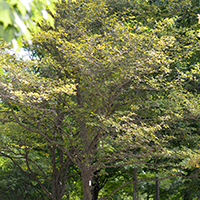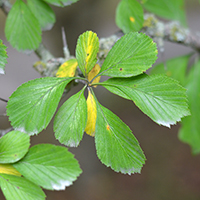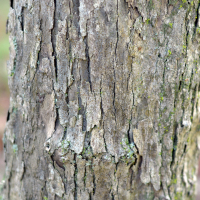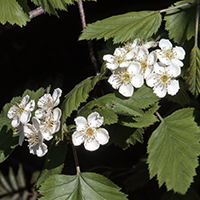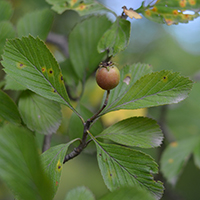What hawthorns look like
Size and shape
- Up to 12 metres tall.
- Small, wide-spreading canopies.
Bark
- Rough shredding bark.
- Thorny twigs.
Leaves
- Small, toothed leaves.
Flowers
- Clusters of white flowers.
Fruit
- Clusters of small, apple-like fruits.
- May persist into winter.
- May be red, orange, yellow or almost black.
Where hawthorns are found
Hawthorns are a group of species adapted to many sites in Ontario, from Southern Ontario to north of Timmins and west along the north edge of Lake Superior to the Manitoba border.
The more common species in Ontario include downy hawthorn (C. mollis), cockspur hawthorn (C. crus-galli), dotted hawthorn (C. punctata) and the most northern species, fleshy hawthorn (C. succulenta).
What you need to know to grow hawthorns
- Moisture: moist to dry soil.
- Soil: prefers rich soils.
- Shade: grows best in full sun but tolerates partial shade.
- Cautions:
- Soil moisture: Hawthorns are tough, adaptable trees but grow best planted in well-drained areas. If planting on heavy, wet soil, plant hawthorns on a mound and loosen the soil in a circle six times wider than the planting hole to a depth of 15 centimetres.
- Thorns: Hawthorns are useful for their ability to tolerate dry, windy areas, but due to sharp thorns are not recommended for schoolyard plantings.
Benefits and uses of hawthorns
Wildlife benefits
- A variety of bird and wildlife species consume hawthorn fruits.
- Some bird species use hawthorn thickets as nesting sites.
- Deer and other small mammals browse young twigs and leaves.
Commercial uses
- Hawthorn berries are edible and can be used in the production of jams and jellies.
- Pretty flowers make hawthorns a desirable landscaping choice. They also make a great hedge/shrub tree.
- Hawthorns are too small for commercial wood products but can be used for small woodworking projects.
Fun facts about hawthorns
- In some areas, hawthorn fruits are known as ‘haws’ or ‘haw apples’.
Updated: November 22, 2023
Published: July 18, 2014
